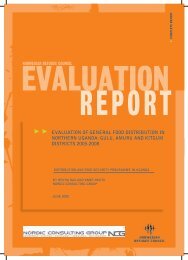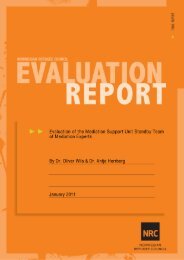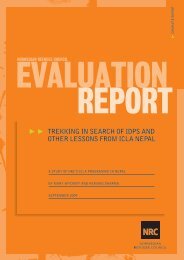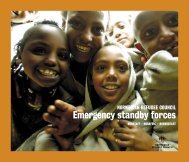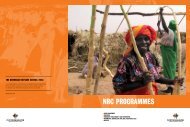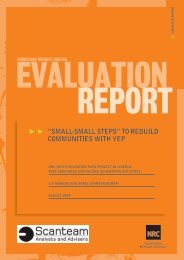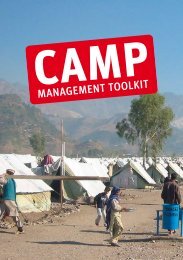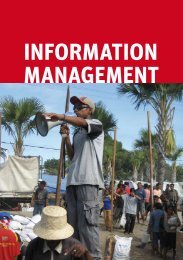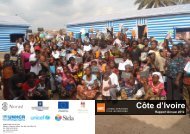Download report here - Norwegian Refugee Council
Download report here - Norwegian Refugee Council
Download report here - Norwegian Refugee Council
Create successful ePaper yourself
Turn your PDF publications into a flip-book with our unique Google optimized e-Paper software.
Evaluation of NRC Food Security and Livelihoods Projects in Chiredzi and Chipinge Districts of ZimbabweKey Recommendations:Ensure that adequate budgetary provision for M&E activities is built into all project proposals,including provision for appropriate staffing resources.Enhance existing M&E structures, either through increased in-house provision or partnershipapproaches.5.9 Project Management and AdministrationNRC is a newly established organization in Zimbabwe, having begun its Zimbabwe operations at thecommencement of the programs being reviewed <strong>here</strong>. Consequently t<strong>here</strong> was an initial lack ofestablished systems and procedures. Several of the problems identified below may be attributable tothe newness of the local organization during 2011. Progress has since been made in addressing theseproblems, and some of the issues identified may t<strong>here</strong>fore to some extent be regarded as historic.T<strong>here</strong> was a lack of coordination and monitoring of budgets, combined with authorization from 3 differentoffices (Chipinge, Chiredzi and Harare) resulted in delays in reconciliations and budget overspends.Reports reviewed varied considerably in format quality, use of qualitative data, focus on impacts, etc.Many were heavily activity focused, rather than addressing impacts or outcomes.Key RecommendationsEnsure timely reconciliations and improved coordination of approval processes.Consider adopting standardised <strong>report</strong>ing frameworks, and increasing staff awareness of theimportance of a results-based monitoring / <strong>report</strong>ing approach.6. EffectivenessOverall, the project was successful in its primary goal of contributing to the durable resettlement andintegration of internally displaced people and returnees by improving their food security and access tosustainable livelihoods opportunities.‣ 84% of beneficiaries <strong>report</strong>ed increased acceptance of IDPs / returnees within the host community.‣ 99.6% of beneficiaries rated the type of assistance they received as “good” (11%) or “very good”(88.6%) at meeting their needs.‣ 84% of beneficiaries <strong>report</strong>ed consuming an increased quantity of food, and 77% <strong>report</strong>edconsuming an increased variety of food. Most of those not <strong>report</strong>ing an increase were goatrecipients, w<strong>here</strong> income benefits have not yet been realized.‣ Average number of meals eaten per day is estimated to have risen from 1.9 to 2.6.‣ 26% of beneficiaries <strong>report</strong>ed an increase in the number of assets owned. In 1% of cases assetsdeclined, mainly due to the need to provide inputs for livestock project (e.g. medicines / feeds).The period of implementation of the initial program (1 year) was not adequate to achieve all the intendedimpacts. In some cases this resulted in them terminating before they were yielding the intended benefits(e.g. small livestock) or before a complete ‘life cycle’ could be completed (CA / crop rotation).Key RecommendationsA longer term approach is needed to increase the tangible benefits secured.A holistic ‘life cycle’ approach would be better able to consolidate gains and / or provide supportbeneficiaries up the productive phase of the livelihood activity.15




